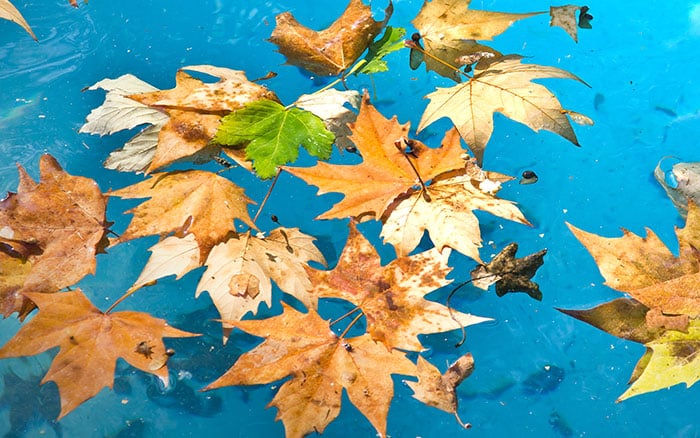It’s been an unusually hot and dry summer this year. And, as a result, many trees have started shedding their leaves early to minimise lack of water stress.
Why net ponds for falling leaves
If you have a pond with trees nearby, it’s important to stop leaves from overhanging branches falling into the water. As those lovely-looking leaves give off nutrients as they decompose in the water. Those nutrients are exactly the food that algae are looking for. And before you know it, your lovely, clear pond will be covered in green algae.
Another thing that decomposing leaves do is release carbon. This takes oxygen from the water, potentially harming pond life, including fish and plants growing in the water.
This potential problem can be easily solved by putting a net over the pond. Autumn is traditionally the best time of year to do this, before the leaves start to fall. As our dry, hot summer has started a premature leaf fall, it’s best to net the pond as soon as possible.

What’s needed
- Pond netting
- Sharp scissors
- Metal pegs or bamboo canes
- Mallet
- Rocks/large stones/sandbags
How to net your pond
Firstly, make sure you have all the above close to hand by the pond before you start.
Ideally, you will have found netting or a cover that completely protects the whole of the pond. If not, cut enough lengths to cover the entire pond.
Lay the netting across the pond, overlapping each other if you’re using more than one piece.
Fix the netting in place on one side with the pegs/canes. This will enable you to pull the netting tight on the other sides. It’s important that the netting doesn’t sag into the water; otherwise, the leaves will just sit decomposing in the netting!
Remove any leaves that fall onto the netting and add them to your leaf mould pile.

Top Tips
- When measuring for the netting, add 50cm/20” beyond the pond’s edges.
- If your pond edging is a continuous hard surface, use large rocks or sandbags to weigh down the edges.
Protecting wildlife
Before netting, consider doing the following:
- Place a tennis ball or other floating object in the pond before netting it. This helps prevent a solid ice layer from forming, particularly important if there are fish or newts in the pond.
- Place a few floating platforms or logs into the pond. This will give wildlife like frogs a resting or refuge spot.
- Be mindful of hedgehogs. Ideally, they should be safely hibernating under a hedge. But with increasingly mild winters, this can disorientate some animals into ending their hibernation early. To avoid hedgehogs falling in through the netting, where possible, keep the netting at least 30cm/12” above the ground. This allows them to pass safely underneath.
- If the pond is steep-sided, add a ramp to a couple of the sides. Make them from either stones, wire mesh, or wood, so that they can climb out.
- Check your pond regularly throughout the autumn and winter.
For more great gardening advice, make sure you head to my YouTube Channel. Make sure you’re subscribed with notifications on so you don’t miss any of my new videos.
Frequently Asked Questions
1 – Why should I net my pond in autumn?
Netting prevents falling leaves from decomposing in the water. This avoids nutrient build-up, which fuels algae, and reduces oxygen loss that can harm fish and plants.
2 – What type of netting is best for ponds?
Choose durable pond netting with small mesh to stop leaves but still allow light and air through. Measure generously—at least 50cm beyond the pond’s edges.
3 – How do I secure pond netting properly?
Use metal pegs, bamboo canes, or rocks to hold it tight around the edges. Avoid sagging into the water so leaves don’t collect and rot on the net.
4 – Is pond netting safe for wildlife?
Yes, if installed thoughtfully. Raise it 30cm above ground to protect hedgehogs, add ramps for steep sides, and leave floating platforms for resting wildlife.
5 – When should I remove the netting?
Keep the netting in place until leaf fall has finished, usually late autumn to early winter. Continue clearing leaves from the net regularly during the season.

Leave A Comment